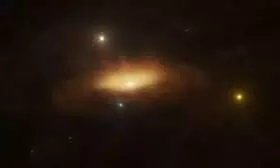
Astronomers witness "unprecedented behavior" as black hole awakens
text_fieldsFor the first time, astronomers have observed a supermassive black hole waking up and igniting its host galaxy, located 300 million light-years away in the Virgo constellation.
This galaxy, which had remained quiet for decades, began to shine brightly in late 2019, capturing the attention of scientists worldwide.
The European Southern Observatory reported on Tuesday that the center of this galaxy, presumed to harbor a supermassive black hole, has since been emitting a range of rays. Paula Sanchez Saez, an astronomer with the observatory and lead author of a new study published in the journal Astronomy & Astrophysics, described the phenomenon as "unprecedented."
Lorena Hernandez Garcia, a co-author of the study, suggested that the brightening could be due to the "activation of a massive black hole in real-time." This scenario is considered the most plausible explanation for the sudden increase in brightness.
Supermassive black holes, like the one thought to reside in this galaxy, are typically invisible because their gravitational pull is so strong that not even light can escape. However, they become observable when they destroy large objects, such as stars, which emit light as they are torn apart.
Claudio Ricci, another co-author of the study, noted that these "giant monsters" are usually dormant. However, in the case of the galaxy SDSS J1355+0728, the black hole appears to have started consuming nearby gas, causing it to become extremely bright.
Preliminary data indicates that this black hole has a mass 1.5 million times that of the Sun, classifying it as a supermassive black hole, though it remains relatively small compared to others that can exceed a billion solar masses.
The international team of astronomers is now analyzing data from various telescopes to determine whether this activity is a temporary event, possibly triggered by a star being ripped apart, or if the black hole will remain active for an extended period.
Hernandez Garcia remarked that a similar event could theoretically happen to our own galaxy's supermassive black hole, Sagittarius A. However, for now, Sagittarius A remains dormant, much to the relief of our galaxy.























